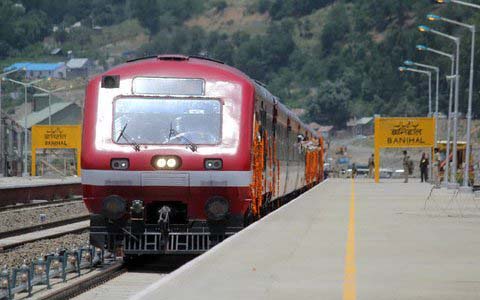JAMMU, JANUARY 31: Udhampur-Srinagar-Baramulla railway line, one of the most remarkable projects of the Indian Government, once completed, will be revolutionary for the Union Territory of Jammu and Kashmir as it will turnaround the economic landscape here.
The railway line will not only give the all-weather connectivity to Kashmir valley but also substantially reduce the transportation costs and will form the backbone of transport of J&K.
The logistics of the track faced many natural challenges as it had to be constructed through major earthquake zone, battling extreme temperatures and hilly terrains. Though the sections from Jammu to Katra and Banihal to Baramulla have been built and are operational, the track from Katra to Banihal is yet to be completed. Moreover, the extension of the railway line up to Kupwara has also been approved.
Tracing back into the annals of history, the first railway track in the erstwhile state was laid in 1897 from Sialkot (Pakistan) to Jammu by the then colonial government. In 1947, with the partition of India, the Jammu-Sialkot line was closed since Sialkot went to Pakistan. As a result, the entire state of Jammu-Kashmir was disconnected from the Indian rail network and Pathankot in the Indian state of Punjab remained the nearest railhead.
Subsequently, In 1975, a rail link was established between Pathankot and Jammu and a renovated Jammu Tawi railway station was opened. It remained at the northern end of the railway line for the next 30 years until the Jammu to Udhampur line was opened in 2005.
The Jammu-Udhampur stretch has 20 tunnels, the longest tunnel is 2.5km long while the highest bridge measures 77m. Sensing the need to connect Kashmir Valley with the northern railway grid, the Government of India declared the Jammu-Baramulla railway line a national project in 2002.
Operationally, the Jammu-Baramulla railway line is divided into four sections:
Leg0: running 53km from Jammu to Udhampur and completed in 2005.
Leg1: running 25km from Udhampur to Katra, dedicated to the nation on 4th July 2014.
Leg2: running 111km from Katra to Banihal which is under construction and has 35 tunnels.
Leg3: running 135km from Banihal to Baramulla, dedicated for public use on 26th June 2013.
One of the significant achievement of Jammu-Baramulla railway line was completion of 11km long Pir-Panjal railway tunnel also known as Banihal-Qazigund tunnel. This tunnel was extremely challenging and its completion was hailed as an outstanding achievement as it was India’s longest rail tunnel. Its average elevation is 1760 m and is 440 m below the Jawahar tunnel. This tunnel gives all weather connectivity to Kashmir valley with the rest of the country.
As of now the construction on Katra-Banihal stretch is going on with full pace. The stretch is not more than 111 km but around 98 km of this stretch comprises bridges and tunnels. Among these bridges will be the one being built across the deep gorge of the Chenab River near the Salal hydroelectric dam. This bridge of steel arches is 1315 m long and at a height of 359 m from the ground. It is an engineering marvel which is 35 m more than the height of the Eiffel Tower.
The project rewards supernumerary benefits too, because it encompasses 262 km of accessory roads connecting 147,000 people in 73 villages. It will foster connectivity, besides strengthening the economy of the region whose innate potential still remains untapped.
This colossal project is the most strenuous rail project undertaken on the Indian subcontinent. The young Himalayas are geologically challenging and problematic. Numerous hindrances have been encountered while tunnelling. The track’s alignment presents one of the greatest railway engineering obstacles ever faced. Only Tibet’s Qingzang railway, completed in 2006 across permafrost and climbing over 5000 m above sea level, is comparable.
Provisions for future electrification for the track will also be made, although the rail line will use diesel locomotives initially. Passenger trains will be provided with high power diesel multiple units and heated, air-conditioned coaches with wide windows, sliding doors and reclining seats. Three aspect colour-light signaling is being installed on the route for safety, and GSM-R equipment may be installed in the future to improve its quality.
In brief, it can be undoubtedly said that the Jammu-Baramulla railway line, once completed, will pay huge dividends to the economy, connectivity, security and development of the Union Territory of Jammu and Kashmir.

